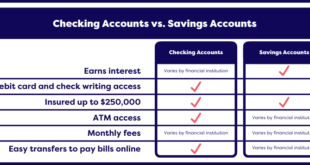Put money in a bank account – In the realm of personal finance, the act of putting money in a bank account is not merely a mundane transaction but a gateway to financial stability and growth. With the right account and strategy, you can safeguard your hard-earned savings, earn interest, and watch your wealth accumulate over time.
This comprehensive guide will unveil the intricacies of bank accounts, deposit methods, fees, interest rates, and more, empowering you to make informed decisions and harness the full potential of your banking experience.
From understanding the nuances of checking and savings accounts to navigating the complexities of online banking and deposit limits, this guide will equip you with the knowledge and confidence to navigate the world of banking with ease. Whether you’re a seasoned investor or just starting your financial journey, this guide will provide invaluable insights and practical tips to help you make the most of your bank account.
Account Types

Navigating the financial world requires understanding the diverse range of bank accounts available. Each account type caters to specific needs and offers unique features. Let’s explore the common types of bank accounts and their distinct characteristics.
Checking Accounts
Checking accounts are designed for everyday financial transactions. They offer easy access to funds through checks, debit cards, and online banking. Checking accounts typically have low minimum balance requirements and allow for unlimited deposits and withdrawals. They are ideal for managing regular expenses, paying bills, and receiving salaries.
Savings Accounts
Savings accounts prioritize the accumulation and growth of funds. They offer higher interest rates compared to checking accounts, encouraging individuals to save for future goals or emergencies. Savings accounts typically have higher minimum balance requirements and limit withdrawals to a certain number per month.
They are suitable for long-term savings plans, such as retirement or down payments on major purchases.
Money Market Accounts
Money market accounts combine features of both checking and savings accounts. They offer higher interest rates than checking accounts and allow for limited check-writing privileges. Money market accounts typically have higher minimum balance requirements and may charge fees for excessive withdrawals.
They are suitable for individuals who need access to their funds while earning a competitive return.
Deposit Methods

Depositing money into a bank account is a crucial aspect of managing your finances. There are various methods available, each offering its own advantages and security measures.
Online Banking
Online banking allows you to deposit money into your account from anywhere with an internet connection. It provides convenience and flexibility, especially for those who prefer to manage their finances remotely.
- Convenience:Deposit funds at any time, from any location with internet access.
- Security:Encrypted and secure platforms ensure the protection of your sensitive information.
Mobile Deposits
Mobile deposits leverage smartphone technology to allow you to deposit checks remotely. This method offers a quick and easy way to deposit funds without visiting a branch.
- Convenience:Deposit checks from anywhere, at any time, using your smartphone camera.
- Security:Advanced fraud detection systems and encryption measures safeguard your transactions.
ATMs
Automated teller machines (ATMs) provide a convenient and accessible option for depositing cash and checks. They are widely available in various locations, including banks, retail stores, and public spaces.
- Convenience:ATMs offer 24/7 availability for deposits, allowing for flexibility in managing your finances.
- Security:ATMs are equipped with security cameras and other measures to deter fraud and protect your funds.
In-Person Deposits
In-person deposits involve visiting a bank branch and handing over cash or checks to a teller. This traditional method provides a personal touch and allows for immediate verification of your deposit.
- Personal Interaction:Interact with a bank representative for assistance and personalized service.
- Immediate Verification:Your deposit is processed and verified on the spot, providing peace of mind.
Deposit Limits and Restrictions: Put Money In A Bank Account
To maintain financial stability and prevent illicit activities like money laundering, banks impose limits and restrictions on the amount of money that can be deposited into an account. These limits vary depending on the bank’s policies, regulatory requirements, and the type of account.
Reasons for Limits and Restrictions
- Fraud Prevention:Limits help banks detect and prevent fraudulent transactions by monitoring large or unusual deposits.
- Money Laundering Prevention:Restrictions help prevent criminals from using bank accounts to conceal the origin of illegally obtained funds.
- Financial Stability:Banks need to manage their liquidity and ensure they have sufficient funds to meet customer withdrawals and other obligations.
Avoiding Exceeding Deposit Limits
- Understand Your Limits:Check with your bank to determine the deposit limits for your specific account type.
- Deposit in Smaller Amounts:If you need to deposit large sums, consider breaking them into smaller deposits over time.
- Use Multiple Accounts:If necessary, open multiple accounts at different banks to distribute your deposits and avoid exceeding limits.
- Contact Your Bank:If you need to make a large deposit that exceeds the limit, contact your bank and provide supporting documentation to explain the source of the funds.
Account Fees
Understanding the fees associated with a bank account is crucial for managing your finances effectively. Bank accounts may come with various fees that can impact your financial situation.
Common types of account fees include monthly maintenance fees, transaction fees, overdraft fees, and minimum balance fees. It’s essential to compare these fees among different banks and account types to find the option that best suits your needs.
Monthly Maintenance Fees
Monthly maintenance fees are charged on a regular basis, typically monthly, for the upkeep of your account. These fees can vary depending on the type of account and the bank’s policies. Some banks offer accounts with no monthly maintenance fees, while others may charge a small fee or a higher fee for premium accounts with additional features.
Transaction Fees
Transaction fees are charged for specific transactions you make using your account, such as ATM withdrawals, wire transfers, or check deposits. The amount of the fee can vary depending on the type of transaction and the bank’s policies. Some banks offer a limited number of free transactions per month, while others charge a fee for each transaction.
Overdraft Fees
Overdraft fees are charged when you spend more money than you have available in your account. These fees can be significant and can quickly add up. To avoid overdraft fees, it’s important to keep track of your account balance and avoid spending more than you have.
Minimum Balance Fees
Minimum balance fees are charged if your account balance falls below a certain amount. These fees can vary depending on the bank’s policies and the type of account. Maintaining the minimum balance required can help you avoid these fees.
Tips for Minimizing or Avoiding Account Fees, Put money in a bank account
- Choose an account with no monthly maintenance fees or low fees.
- Limit your transactions to avoid transaction fees.
- Keep track of your account balance to avoid overdraft fees.
- Maintain the minimum balance required to avoid minimum balance fees.
- Consider using a bank that offers fee-free or low-fee accounts.
Interest Rates and Earnings
Interest rates are the charges levied by banks for borrowing money and the returns provided to depositors for keeping their money in the bank. Interest rates significantly influence the earnings on a bank account. Higher interest rates lead to higher earnings, while lower interest rates result in lower earnings.Different
types of interest rates exist, including fixed rates, variable rates, and tiered rates. Fixed rates remain constant throughout the term of the deposit, while variable rates fluctuate based on market conditions. Tiered rates offer different interest rates for different deposit amounts, with higher rates for larger deposits.Interest
earnings accumulate over time through the process of compounding. Compounding refers to the interest earned on both the principal amount and the accumulated interest. As a result, the interest earnings grow exponentially over time, leading to substantial returns on long-term deposits.
Example:If you deposit $1,000 in a savings account with a 5% annual interest rate, compounded monthly, you will earn $50 in interest in the first year. In the second year, you will earn interest not only on the $1,000 principal but also on the $50 interest earned in the first year. This results in earnings of $52.50 in the second year. Over time, the accumulated interest earnings will continue to grow, leading to significant returns.
Final Summary

As you embark on your financial journey, remember that putting money in a bank account is not just a simple act but a powerful tool for securing your present and future. By choosing the right account, maximizing interest earnings, and minimizing fees, you can harness the power of compound interest and watch your savings grow exponentially over time.
The world of banking is vast and ever-evolving, but with the knowledge gained from this guide, you can navigate its complexities with confidence and achieve your financial goals.
FAQ Insights
What are the different types of bank accounts available?
There are several types of bank accounts available, including checking accounts, savings accounts, money market accounts, and certificates of deposit (CDs). Each type of account offers unique features and benefits, such as varying interest rates, transaction limits, and access to funds.
How can I deposit money into my bank account?
There are several convenient ways to deposit money into your bank account, including online banking, mobile deposits, ATMs, and in-person deposits at a bank branch. Each method offers its own advantages and security measures.
Are there any limits or restrictions on how much money I can deposit into my account?
Yes, there may be limits or restrictions on the amount of money you can deposit into your account, depending on the type of account and the bank’s policies. These limits are in place to prevent money laundering and other financial crimes.
What are the fees associated with opening or maintaining a bank account?
Some banks may charge fees for opening or maintaining a bank account, such as monthly maintenance fees, overdraft fees, and ATM fees. It’s important to compare fees and choose an account that meets your needs and minimizes costs.
How do interest rates affect my bank account?
Interest rates play a crucial role in determining how much your savings will earn over time. Higher interest rates mean your savings will grow faster, while lower interest rates will result in slower growth. It’s important to understand how interest rates work and how they can impact your financial goals.
 Nenroll Nenroll News
Nenroll Nenroll News




